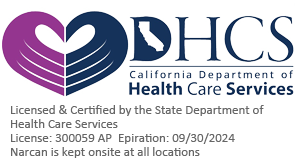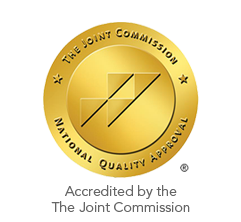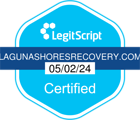Many people are surprised to learn how closely trauma, domestic violence, and substance use disorders are connected. Experiences of abuse can leave lasting effects on the brain and body, making recovery from addiction more complex. Understanding this connection is important for anyone exploring trauma and addiction recovery or seeking information about domestic violence and addiction.
A trauma-informed approach to addiction treatment means recognizing how abuse and trauma can shape someone’s mental health and substance use. This perspective helps address both the emotional wounds and the behaviors that may develop afterward.
At Laguna Shores Recovery in Dana Point, California, located in Orange County, we understand the deep connection between trauma and addiction and offer comprehensive, trauma-focused therapy that addresses both the emotional and psychological scars left behind.
What is Domestic Violence and Why Does it Lead to Substance Use?
Domestic violence is a pattern of behaviors used by one partner to control or dominate another in an intimate relationship. This abuse takes many forms beyond physical violence. Emotional manipulation, threats, intimidation, financial control, and unwanted sexual contact all qualify as domestic violence.
The connection between domestic violence and substance use disorders is well-documented. Research from the Substance Abuse and Mental Health Services Administration (SAMHSA) shows that women who experience domestic violence are significantly more likely to develop substance use problems.
Trauma from abuse disrupts the brain’s normal stress and reward systems. When someone experiences repeated fear, pain, or humiliation, their brain changes how it processes stress and pleasure. This makes them more vulnerable to addiction, as drugs or alcohol might temporarily reduce distressing feelings or memories.
For many survivors, using substances becomes a way to manage trauma symptoms. This is called self-medication. People may drink or use drugs to:
- Numb emotional pain: Alcohol or drugs temporarily block feelings of sadness, anger, or fear
- Quiet nightmares: Substances can help suppress disturbing dreams or flashbacks
- Reduce anxiety: Drugs may provide short-term relief from panic or constant worry
- Escape reality: Intoxication offers a temporary distance from painful memories
Over time, this coping strategy can develop into a substance use disorder, creating new challenges on top of the original trauma
Common signs of abuse in relationships
Abuse in relationships often follows patterns that may become normalized over time. Recognizing these signs can help identify unhealthy or dangerous situations.
Emotional abuse involves actions that affect a person’s thoughts, feelings, and self-worth. Common manipulative behaviors include:
- Gaslighting: Making someone doubt their own reality or memory by denying events or saying things like “that never happened.”
- Constant criticism: Putting someone down regularly, often disguised as “jokes” or “helpful advice”
- Withholding affection: Using love, attention, or intimacy as rewards or punishments
- Threatening self-harm: Saying things like “I’ll hurt myself if you leave” to control behavior
Abusive language often includes phrases like “You’re too sensitive,” “No one else would love you,” or “You’re imagining things.” These comments are designed to make the victim question themselves and become more dependent on the abuser.
Emotional abuse creates psychological trauma that can lead some people to use substances to cope with pain, anxiety, or depression.
Financial abuse happens when one person controls access to money and resources. This type of abuse includes:
- Controlling all spending: Not allowing a partner to make any financial decisions
- Preventing employment: Sabotaging job interviews, showing up at workplaces, or forbidding work
- Hiding assets: Keeping bank accounts, investments, or property secret
- Creating debt: Opening credit cards or taking loans in the victim’s name
Isolation tactics often accompany financial abuse. Abusers may forbid contact with friends and family, monitor phone calls and texts, or move their partner away from support systems.
When someone lacks social and financial support, they may turn to substances for comfort. The stress of isolation combined with financial dependence can make addiction more likely and recovery more difficult.
Physical abuse extends beyond visible injuries. Warning signs include:
- Unexplained injuries: Bruises, cuts, or burns with unclear explanations
- Frequent “accidents”: A pattern of injuries blamed on clumsiness or mishaps
- Concealing clothing: Wearing long sleeves, high necklines, or sunglasses to hide marks
- Flinching or startling: Reacting with fear to sudden movements or loud noises
The cycle of violence typically follows a pattern: tension builds, violence occurs, followed by apologies and promises to change. This cycle often mirrors substance use patterns, with periods of sobriety followed by relapse.
Sexual abuse within relationships can include forced sexual activity, withholding intimacy as punishment, or using sex to “make up” after violence. Survivors of sexual trauma frequently use substances to cope with shame, guilt, or symptoms of post-traumatic stress disorder.
How Trauma Fuels Addiction and Impacts Recovery
Trauma causes people to react in different ways, often described as fight, flight, freeze, or fawn responses. Each response can connect to specific patterns of substance use:
- Fight response: Anger and aggression may lead to using stimulants or alcohol for confidence
- Flight response: Anxiety and restlessness might result in using substances to escape or calm nerves
- Freeze response: Numbness and disconnection can lead to using depressants to avoid pain
- Fawn response: People-pleasing behavior may involve using substances to fit in or reduce social stress
Post-traumatic stress disorder (PTSD) can develop after experiencing or witnessing trauma. PTSD symptoms include intrusive memories, nightmares, flashbacks, hypervigilance, and emotional numbing. Many people with PTSD use drugs or alcohol to manage these symptoms, which can lead to co-occurring disorders requiring dual diagnosis treatment.
Adverse childhood experiences (ACEs): ACEs involve trauma during childhood, such as abuse, neglect, or witnessing violence. The Centers for Disease Control and Prevention (CDC) research shows that ACEs increase the risk of developing addiction later in life.
Trauma bonding: Trauma bonding creates an emotional attachment between a victim and an abuser. This psychological connection can make it harder to leave abusive relationships and increase the risk of returning to substance use during recovery.
Barriers to Receiving Treatment
The period when someone tries to leave an abusive relationship is often the most dangerous time. Violence frequently escalates when abusers sense they’re losing control. Some abusers use substances as a control method, either encouraging drug or alcohol use or forcing it.
Safety planning becomes more complex when substance use is involved. Withdrawal symptoms, the need for medical supervision, and concerns about confidentiality can make it harder to seek help safely.
Economic abuse can leave someone with no savings, poor credit, and complete financial dependence on their abuser. This financial control makes leaving extremely difficult.
Housing presents another major barrier. Some shelters have restrictions that make it challenging for people with substance use disorders to access services. Many residential treatment programs don’t allow children, creating additional obstacles for parents seeking help.
Stigma around both domestic violence and addiction can be particularly strong in certain communities. Victims may face blame for the abuse they experienced, while addiction is sometimes viewed as a moral failing rather than a health condition.
Internalized shame makes many people feel unworthy of help or fear judgment from others. This shame can prevent someone from reaching out for treatment or support services.
Effective approaches for trauma and addiction recovery
Trauma-informed care is built on six key principles: safety, trustworthiness, peer support, collaboration, empowerment, and cultural sensitivity. This approach recognizes that many people seeking addiction treatment have experienced trauma.
At Laguna Shores Recovery, trauma-informed approaches are integrated into all levels of care. This means staff are trained to recognize trauma symptoms and avoid re-traumatization during treatment.
Dual diagnosis treatment addresses both substance use disorders and mental health conditions like PTSD simultaneously. This integrated approach is more effective than treating each condition separately. Common types of addiction counseling we utilize include:
- Eye Movement Desensitization and Reprocessing (EMDR): EMDR helps process traumatic memories
- Cognitive Behavioral Therapy (CBT): CBT addresses negative thought patterns and behaviors
- Dialectical Behavior Therapy (DBT): DBT teaches emotional regulation and distress tolerance skills
- Group therapy: Group therapy provides peer support and reduces isolation
Treatment plans are individualized based on each person’s specific trauma history, substance use patterns, and recovery goals.
Holistic approaches address the physical, emotional, and spiritual impacts of trauma and addiction. These may include mindfulness practices, yoga, nutrition counseling, art therapy, and exercise programs.
Ongoing support through alumni groups, peer mentors, and relapse prevention programs helps maintain long-term recovery. Laguna Shores Recovery incorporates holistic methods as part of comprehensive care that addresses the whole person.
Resources for Domestic Violence and Addiction
The National Domestic Violence Hotline provides confidential support 24/7 at 1-800-799-SAFE (7233). Trained advocates can help with safety planning, local resources, and emotional support.
SAMHSA’s National Helpline offers free, confidential treatment referrals at 1-800-662-HELP (4357). This service operates 24/7 and provides information about local treatment facilities and support groups.
When contacting these resources, use a safe device that can’t be monitored, clear browser history afterward, and make calls when the abuser isn’t present.
Protective orders are legal documents that can help keep someone safe from an abuser. Types include restraining orders, emergency protective orders, and no-contact orders.
Legal aid organizations and domestic violence programs often provide free assistance with filing protective orders and navigating court processes. When substance use is involved, ask about confidentiality protections and how this information might be used in legal proceedings.
Domestic Violence and Addiction FAQs
Yes, outpatient treatment options allow someone to receive help while maintaining their living situation. Safety planning is essential, and treatment providers can help develop strategies that minimize risk while addressing substance use.
Many treatment centers offer sliding scale fees based on income, and state-funded programs provide services regardless of ability to pay. The SAMHSA National Helpline can provide information about free and low-cost treatment options in your area.
Trauma-informed care recognizes that many people with addiction have experienced trauma and adjusts treatment accordingly. This approach emphasizes safety, avoids re-traumatization, and addresses both trauma and addiction simultaneously rather than treating them as separate issues.
Recovery from both domestic violence and addiction is possible with proper support that addresses trauma, substance use, and rebuilding self-worth together. Many survivors achieve lasting recovery through integrated treatment approaches that recognize the connection between these experiences.
Healing requires addressing not just the addiction, but also the underlying trauma that may have contributed to substance use. This comprehensive approach helps people develop healthy coping strategies and build the emotional resilience needed for long-term recovery.
You’re Not Alone: Help and Healing are Possible
At Laguna Shores Recovery in Dana Point, CA, we provide specialized, trauma-informed care for individuals who have experienced both domestic violence and addiction. Our treatment programs are designed for people with complex histories, recognizing how trauma and substance use often overlap and influence each other.
If you or someone you know is struggling with both domestic violence and addiction, help is available. Contact Laguna Shores Recovery to start your recovery journey or verify your insurance coverage.

 Matthew Beck B.A, M.A, LMFT
Matthew Beck B.A, M.A, LMFT 


